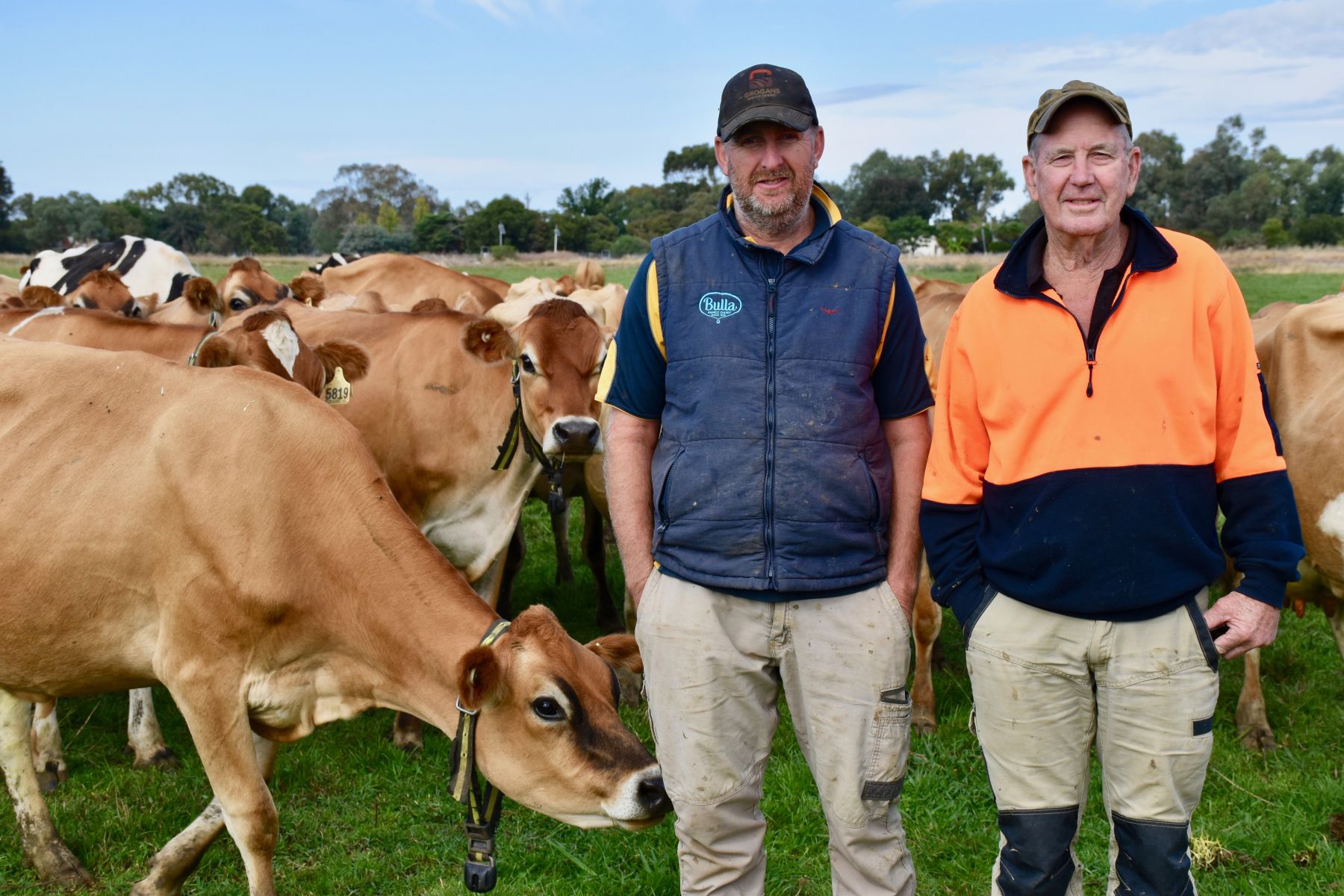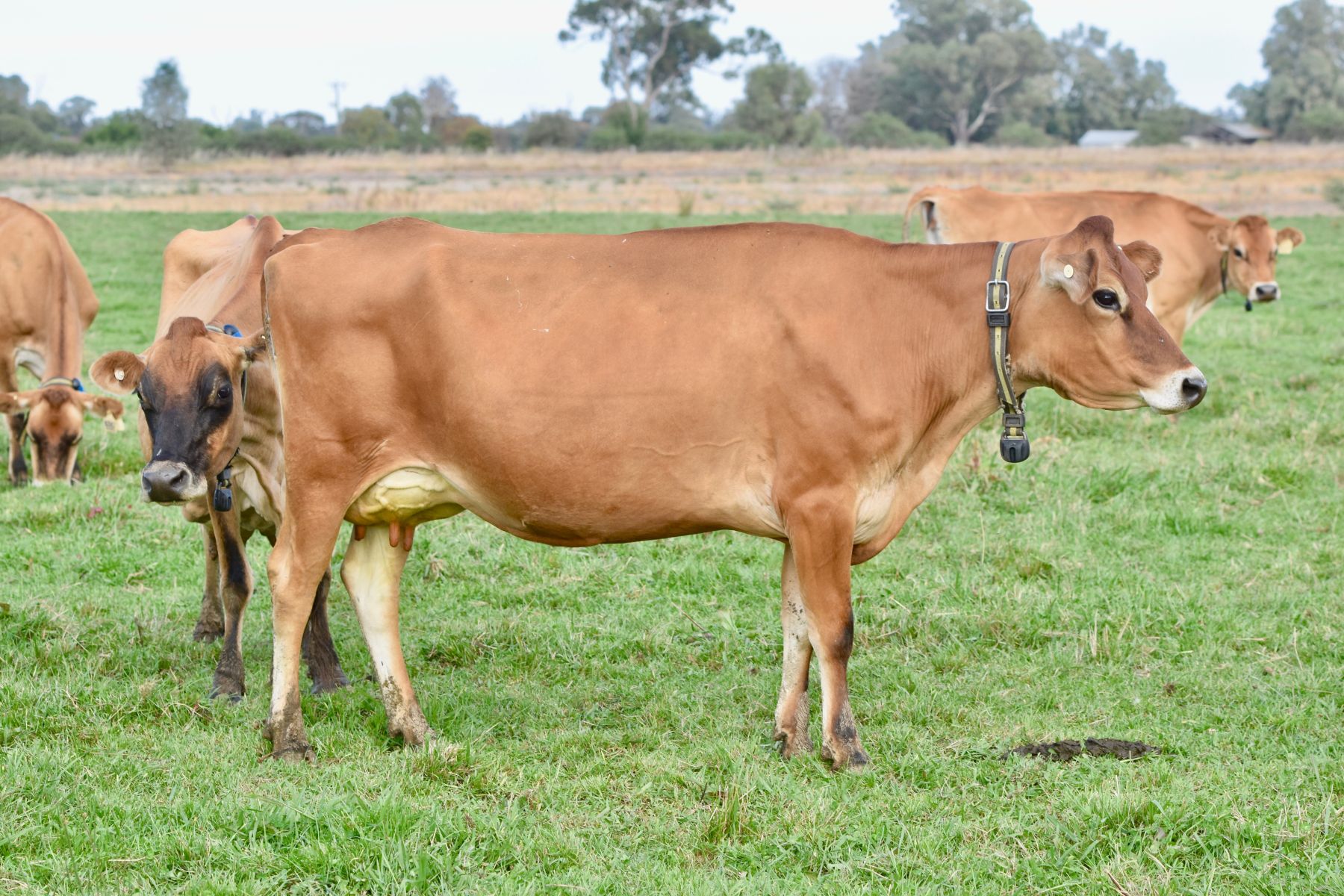Genetic gains underpinned by industry breeding tools
Cochrane family
Region: Northern Victoria
Topic: BPI
Victorian dairy farmer Bill Cochrane has boosted his herd’s genetic gain by 310% thanks to industry tools such as genomics, sexed semen and Good Bulls.
Craigielea Jerseys from Bamawm, Victoria, recorded a rise of 168 Balanced Performance Index (BPI) between 2020 and March 2024, according to DataGene’s review of herd performance.
This BPI lift was one of the most significant across herd recording Australian dairy farms.

Bill and Andrew Cochrane, Craigielea Jerseys, Bamawm, Victoria have bred the equal top Jersey cow, Craigielea Vicky 6151 VG 87 in DataGene’s April 2024 release of the Australian Breeding Values (ABVs).
Bill Cochrane owns and operates Craigielea Jerseys with his wife Kaye and son Andrew.
Their dairy farm is in expansion mode, with the herd growing from 450 cows to milking 550 this coming season thanks to the purchase of additional land.
Bill attributes the rise in BPI to genomic testing and “losing the bottom of the herd”.
“We trusted genomics when it first came in and we were quite happy to use a bull just on his genomic figures,” he said.
“Genomics also played a role in eliminating the bottom end of our herd. For the past three or four years we’ve used beef on the bottom – according to genomics – and sexed semen to breed our heifers. Years ago, we’d just chuck a bull in with our heifers, but they are our better animals and using sexed semen ensures we breed our replacements from them.”
The bottom 20% of the Craigielea herd – based on genomic results – is joined to beef semen.
Previously, these calves were sold to a calf rearer to fulfil a meat contract, but in the past year Bill and his family have retained them to grow-out.
Breeding the “bottom” of the herd to beef “takes the temptation away to keep the wrong calf” and ensures the Cochranes can double-down on their strategy of breeding replacements from the best animals.
In recent years the Cochranes’ use of sexed semen has boosted their heifer stocks and they’ve used genomic data to make better decisions on which ones to retain.
Bill said genomics has taken the guesswork out of breeding decisions.
“I know what I’m going to get and that means there’s less wastage,” he said. “We know what we are going to get, so we don’t end up culling cows on their first lactation because they don’t meet expectations. Obviously, there’s environmental factors that can play a role (in the success of the cow) but when we make a mating, we know what’s coming and have a reasonable idea of what it will look like and what it will work like.”
Thanks to the influx of heifer calves in recent years, Craigielea has sold groups of 30-40 young cows, opening a new income stream.
These sales are in addition to sales of individual, high BPI heifers that they sell at elite multi-vendor auctions.
With herd growth on the agenda in the coming few years, Bill and his family will be retaining most heifers. He anticipates returning to selling lines of young cows in a few years.
Craigielea – which includes about 15% Holsteins – has worked with DataGene as a GINFO herd since 2019.
GINFO is a large-scale genotyping project, which operates as Australia’s national reference herd for genetic and performance information, to increase the reliability of Australian Breeding Values (ABVs) and indices.

The Cochranes’ top BPI cow, Craigielea Vicky 6151 VG 87.
Since December 2023, the Cochranes’ cow Craigielea Vicky 6151 VG87 has sat at the top of the Australian Breeding Value (ABV) Jersey rankings at 502 BPI. In April 2024, this cow was joined in first place by Araluen Park Jiggy Sandra.
Bill said individually mating each cow based on advice from their breeding consultant has also contributed to Craigieleas’ genetic gain. These bulls are all Good Bulls – they carry DataGene’s Good Bulls logo – which means they meet the minimum BPI and reliability criteria and are available for purchase.
The Cochranes’ breeding philosophy is commercially focused with an eye on the future.
“We are breeding to get a cow that’s going to get in-calf, that is going to last, milk – pay the bills – and we don’t want to be turning the herd over every three or four years either, so they’ve got to be healthy,” he said.
“Ideally, the heifers we are milking now – we’d still want to be milking them in four years’ time.”
DataVat is a web portal the allows farmers access to customised reports and tools based on their own herd and business records.
For more information www.datavat.com.au or email abv@datagene.com.au.


